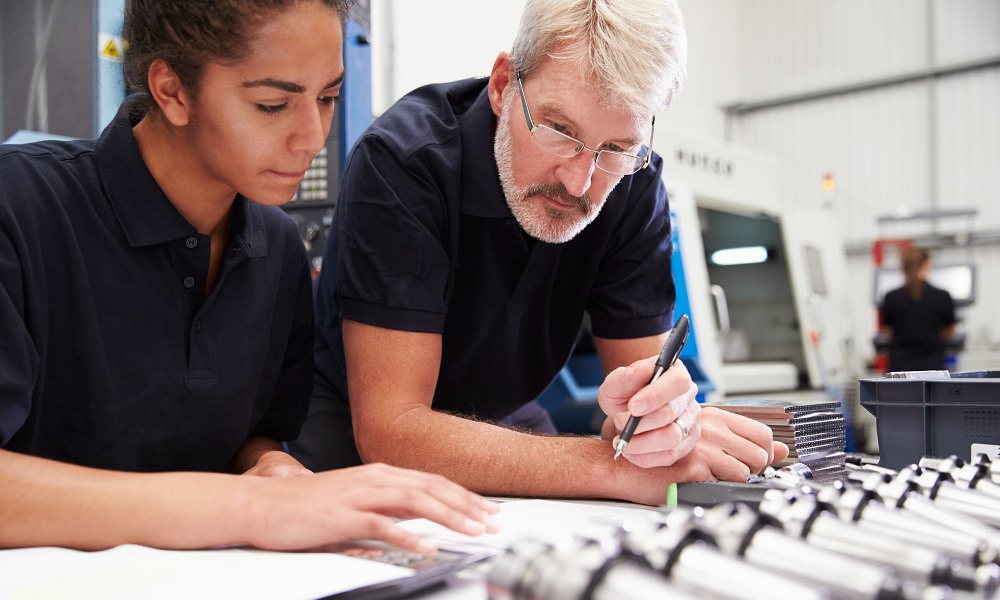This podcast from Teacher magazine is supported by Child Play Therapy at Deakin University. Deakin offers a range of workshops and masterclasses for your professional development. Our annual 2-day Foundations of Child Play Therapy workshop will provide you with practical skills to apply in your current teaching or counselling practice and is also a great introduction to this innovative approach to mental health in children and adolescents. Visit deakin.is/play for more information.
Hello, thank you for downloading this podcast from Teacher magazine – I'm Dominique Russell.
In this special episode I'm joined by Dr Alan Finkel, Australia's Chief Scientist, to talk about his most recent final report, titled ‘Optimising STEM Industry–School Partnerships: Inspiring Australia's Next Generation'. We speak about why partnerships with STEM industries can be beneficial for students, and how schools can work towards implementing such a program.
Dominique Russell: So, in the beginning of the report, some important terms that are often interpreted in different ways are outlined. Could you define ‘enterprise skills', ‘STEM skills' and ‘digital proficiency'?
Dr Alan Finkel: Sure, Dominique. When we started this process, I was overwhelmed by the plethora of terms and the inconsistency with which they were used. So through our panel on the forum we decided we'd tackle that and we managed to reduce the critical terms to three. STEM skills, digital proficiency and enterprise skills.
Now, STEM skills, those are the deep discipline skills that reflect themselves in knowledge and ultimately in careers. Such as a molecular biologist needs to know chemistry and genomics and statistics to be proficient in what they're doing. And, realistically, only a modest number of young people need to train at that level. I don't know, it's a moving target – we can't get firm numbers on this – but it might be 20 or 25 per cent or 30 per cent who will be needed to be trained in those fields to the depth that we're talking about to have careers in STEM.
The second term that we defined was digital proficiency. And digital proficiency is often out there called ICT capabilities or digital literacy. Digital proficiency is the ability to use apps, spread sheets, word processes, recording devices, digital technology and integrate them into everything that you're doing in your future career. At least 90 or 95 per cent of kids will have to be well trained in digital proficiency. It's not a choice in the modern world.
The third term is enterprise skills which is often called 21st century skills, soft skills, general capabilities – there were just so many different ways to describe it. It's the creativity, the project management capabilities, communications, resilience, understanding of ethics. You'd hope that 100 per cent of students have that capability. So, progressively – in terms of percentage of use – we identified STEM skills, digital proficiency and enterprise skills and tried to use only those three terms throughout our report.
DR: Now, the report also says that its recommendations really aim to optimise the way that industry partnerships can work towards a contemporary and internationally competitive STEM education in Australian schools. So, we'll get to the international examples a little later, but what is meant by ‘contemporary STEM education'? What does that really look like?
AF: Well, a contemporary STEM education truly has elements of the traditional in it as well as some of the more modern things. But the traditional elements are actually very, very important. To get a good STEM education, students need deep discipline knowledge. In Chemistry or Physics, or it could be Digital Technologies. But whatever they're learning, that knowledge has to be deep.
The students need to be proficient users of technology. In school and ultimately in whatever careers they might adopt. We are using technology as props to amplify our capabilities. Now, what we know is you can't just throw technology at a problem out in the workforce, and you can't expect technology to make education better. When The Federal Government tried the ‘every child gets a laptop' program and left it at that, it didn't help at all. But if you use technology to assist the delivery of content by the teacher, to provide a high-speed interactive feedback to collectively see how the class is progressing, to feed to the students via the teacher wonderful videos and tests and quizzes and things like that. That technology can help in education just like technology helps an engineer or a scientist in the pursuit of their job. So, proficient users of technology is a key element of a contemporary STEM education. Of course, we are using the term STEM to make it clear that we're talking about an integrated approach to the disciplines. So, through a contemporary STEM education, we are trying to help the students recognise the interactive opportunities between Maths and Physics and Chemistry and Digital Technologies – whatever it is that they're learning – as well as the creative areas.
And another important aspect of a contemporary STEM education is a deep understanding for and respect of the social impact of these technologies. It's the workforce opportunities, of course, but it's the impact of what technology does to the way people live, to the way people interact, and to everything in our society.
DR: And it's also said that teachers are central to developing and maintaining STEM industry partnerships, and there are a number of case studies outlined in the report which give some really excellent examples of how schools are partnering with industries quite successfully. So why are these case studies good examples of industry partnerships? What is it that they're doing?
AF: Well, we'd have to take a couple and go through them. So, one that's in the report is the Victorian Tech School system. I had the pleasure of going out to the Tech School on the Box Hill TAFE campus. First thing I'll say about Tech Schools is that the name doesn't actually indicate what they are. They're not tech and they're not schools. They're a facility on a campus of a university or a TAFE. So the location is important – it's mutual territory and intellectually engaged. What they are is they're a hub, a central facility that brings together 20 to 30 schools in the region through this facility and connects them to a handful or more of companies, of industries. And at the Tech School there's another handful (maybe five or six) teachers and technicians who are experts in certain areas and they work with the companies to identify problems, real world challenges that the kids might be interested in.
The particular Tech Schools I went to, they'd been working with some local hospitals and companies who are providing ICU (Intensive Care Unit) facilities and they'd fitted out this Tech School with really a lot of equipment to do electronics and software for sound and robotics. And the particular challenge that was underway when I went there that was being addressed by Year 9 boys and girls was to develop an entertainment system for an Intensive Care Unit bed in a hospital. These kids had only been there for half a day, or about that, and they'd already plugged together and made systems that in some cases they'd be getting the sound source form the internet, some from their phones, some from radio, and they were having the time of their lives. But they were being guided through this process by the experts who are always at the Tech School, the teachers, and the context was a real-world context that had come from the local hospital. Because industry is a broad interpretation, it doesn't have to be a manufacturer, it can be government or bank or a tourism association or a manufacturer.
And the local schools, they come in one at a time, they're bussed in and they can have three days in a row working at the Victorian Tech School. So it's bringing real-world context, contributions from the industry in terms of capabilities and definition of the challenge in the context, with experts at the tech school facility. The students come in, their teachers come in – so their teachers are getting a professional learning opportunity from the resident teachers and experts at the tech school – at the same time as the kids are being motivated and actually learning something significant. It's not a shallow touch, they learn how the technology is being used and what the scientific principles are behind that.
DR: Another quite interesting aspect was that it's said that neither schools nor industries are often quite sure about how to actually approach a partnership. In this sense, you've said that an intermediary organisation can be quite valuable. Can you describe a little more about the role of an intermediary in this sense?
AF: Certainly. So the word ‘intermediary' in this context is typically talking about a university or a TAFE. Schools and industry – they want to work together. This is not something being imposed on them, they enjoy this relationship, but they do find that they speak different languages and have different understandings and different capabilities and it's our experience – through the consultations and also my personal experience – that bringing in a university or a TAFE partner to what would otherwise be a relationship between an industry and a school can really help.
I'll give you two examples – one personal and one more general. Back in 2006 I had the opportunity of developing a hands-on science technology program for Year 9 students called STELR. And STELR is delivered by the Australian Academy of Technology and Engineering. It's interesting because it's [an] in-class program, so it's co-curricular if you like, it's aligned to the Australian Curriculum. The decision to deliver a STELR unit is made by the school, so that once the school puts up its hand and volunteers (‘we want to do it') then every kid in Year 9, or every kid in Year 8, depending on what year they do it, or 7, will participate for six, seven or eight weeks in the STELR program. We found it great context, which was that the kids were very concerned about growing up in a world of global warning and climate change and that one way to address that, to mitigate it, is to convert from fossil fuel electricity to renewable electricity.
So we built the unit around renewable electricity. It turns out with solar, wind and hydro, you can teach a lot of Physics and some Maths thrown in. So we developed a hands-on kit and a program around that. And we did that through our own resources at the Academy of Engineering in consultation with professors from Deakin University and then later on as we started to go into the delivery phase we found it was important to provide one or two days of professional learning for the teachers who are delivering STELR into the classroom. And certainly part of the professional learning is the obvious of how do you use the STELR equipment and the STELR resources, but a lot of it was inquiry-based learning, because it was an inquiry-based learning unit, and how do you integrate that information about the STELR resources with your already inquiry-based learning capabilities? We asked and got the professors from Deakin University to do that professional learning for us. So, it was the Academy of Technology and Engineering, which is people from industry, from academia, the schools and Deakin University in that case as an intermediary.
Another very big one is the partnership between Google Australia and the University of Adelaide to deliver professional learning in the new Digital Technologies Curriculum. The curriculum came along as an opportunity, schools want to deliver it. There were very few, if any, teachers trained to deliver that new curriculum. Google, of course, has expertise in those kinds of areas and Google got together with University of Adelaide. Google contributed I think some financial resources, some technological resources and some context and expertise in the area. The University of Adelaide has full responsibility for the pedagogy, the teaching and marking of this course which was co-developed with Google and it's been extraordinarily successful. Something like 10 000 teachers have done this online course, which now also has a face-to-face learning practice community, but something like 10 000 teachers have done this course. It would not have been possible if Google was doing it themselves, it actually would've been really hard to imagine it being successful if University of Adelaide had been doing it themselves, but the partnership has been extraordinarily successful.
DR: Now in terms of international examples of exceptional STEM performance, Singapore is a fantastic one. How did they become such a great performer and how is this turnaround relevant to schools here?
AF: Well, Singapore, of course has some advantages that we don't have which is being a single jurisdiction, so they can make a decision and then run with it. So, they had made the requirement to do Science and Mathematics right through secondary school a strict requirement. They've committed to having specialist teachers in Maths and Science starting in upper-primary school all the way through. They also require that their teachers do 100 hours of professional learning per year of which some of it has to be discipline specific. And that is a good example of one of our recommendations. We've suggested in our report that given the teachers in Australia have to do 20 hours a year of professional learning, but currently in most jurisdictions that's left to the teacher and the principal to work out exactly what they will be doing – well given that they're doing it anyway, we recommended that some of it should be discipline specific and taught by an accredited provider, so that teachers who happen to be teaching out-of-field get the benefit of ongoing training in the field they're teaching or teachers who are years past their initial training get the benefit of being updated. So we've learnt from Singapore in formulating that particular recommendation although it came to us through various other means during the consultation as well.
DR: And just finally, then, on a bit of a lighter note, if you were to enter a classroom in the future – in 2030 – what would you want to see?
AF: Human teachers. Let me elaborate. The last thing I'd want to see is robots in charge of the classes. We are going into a world of AI (artificial intelligence), we are going into a world of technology and robots will be doing more and more for us and if they are there in an assisting capacity, fabulous. No problem with that. But young people, they need peer-to-peer relationships. Young people, they need peer-to-teacher relationships. And I am talking about a human relationship. So I'll use the word humanity, I'd like to see humanity in the classroom – but I'm not using it in its normal sense – I really mean I'd like to see humans doing the teaching and doing it well with a focus on conveying deep discipline skills combined with those enterprise skills we talked about, and fun. There's no reason to trade off one for the other. You can chase expertise and quality at the same time as you're having fun.
DR: Well, Dr Alan Finkel, thanks so much for spending time with Teacher magazine today.
AF: Dominique, my pleasure.
That's all for this episode – to keep listening or to download all of our podcasts for free, whether it's another Special episode or our series on Global Education, Behaviour Management, School Improvement, Teaching Methods, Action Research or the Research Files, just visit acer.ac/teacheritunes or soundcloud.com/teacher-ACER. The full transcript of this podcast is available at teachermagazine.com.au. That's where you'll also find the latest articles, videos and infographics for free.
This podcast from Teacher magazine is supported by Child Play Therapy at Deakin University. Deakin offers a range of workshops and masterclasses for your professional development. Our annual 2-day Foundations of Child Play Therapy workshop will provide you with practical skills to apply in your current teaching or counselling practice and is also a great introduction to this innovative approach to mental health in children and adolescents. Visit deakin.is/play for more information.
Thinking about your own school context, how have you worked towards increasing the value of your STEM education? Have these plans ever involved collaborating with people outside your school community?
Dr Alan Finkel suggests involving an ‘intermediary’ organisation, such as a University or TAFE, when establishing a STEM industry partnership. How would you go about developing such a partnership?
The full report is available for download (4.90 MB).



